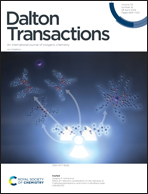Spin crossover in {Fe(pyrazine)[M(CN)4]} (M = Ni, Pt) thin films assembled on fused silica substrates†
Abstract
Thin films with thicknesses in the range between ca. 10–50 nm of the spin crossover (SCO) compound {Fe(pyrazine)[μ4-M(CN)4]} (M = Ni, Pt) have been deposited on fused silica substrates using a sequential assembly method and 4-pyridinecarboxylic acid as anchoring layer. Film morphology and crystallinity were assessed by means of atomic force microscopy and grazing incidence X-ray diffraction, respectively. The intensity of the π–π* transition of the pyrazine ligand at 270 nm, being rather insensitive to the spin state of the complex, was used to follow the film growth as a function of different deposition parameters. On the other hand, the spin state changes were inferred from the temperature dependence of absorption bands appearing at 540, 490 and 310 nm in the low spin state. In line with their amorphous nature, each film displays a very gradual thermal spin crossover between ca. 100–300 K, independently of its thickness and deposition conditions. These results are not only interesting to better understand the effects of size reduction and organization on the SCO phenomenon, but the deposition of these SCO compounds on electrically insulating and/or optically transparent oxide surfaces opens also the door for various photonic or electronic applications.
![Graphical abstract: Spin crossover in {Fe(pyrazine)[M(CN)4]} (M = Ni, Pt) thin films assembled on fused silica substrates](/en/Image/Get?imageInfo.ImageType=GA&imageInfo.ImageIdentifier.ManuscriptID=D4DT00454J&imageInfo.ImageIdentifier.Year=2024)
- This article is part of the themed collection: Recent progress and perspectives on spin transition compounds


 Please wait while we load your content...
Please wait while we load your content...